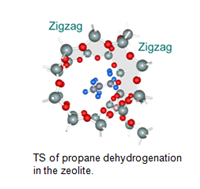วุฒิการศึกษา
- Ph.D. (Chimie-Physique) Université Bordeaux 1, FRANCE
- Ph.D. (Chemistry), Kasetsart University
- B.Sc. (Chemistry, 2nd Class Honours), Kasetsart University
งานวิจัย
Molecular Modeling and Simulation in Homogeneous and Heterogeneous Catalysis
- Ligand-Oriented Catalyst Design for a-Olefin Polymerization and Ring-Opening Polymerization (ROP) of Lactide
Quantum chemical calculations at the density functional theory (DFT) level are applied for elucidating the catalytic activity of the newly developed homogeneous single-site catalysts in the α-olefin and lactide polymerization. The ligand-oriented catalyst design concept is exploited with the assistance of the quantum chemical analyses to discover the new family of highly active catalysts. - Mechanisms of Zeolite-Catalyzed Reactions
Investigation of the catalytic mechanisms in heterogeneous catalysis is experimentally rather difficult or, in some cases, even impossible due to the complicated structure of catalysts and vigorous operating conditions. This research is aimed mainly at improving understanding of the molecular reaction mechanism of substrates in the nanostructured zeolite catalysts by means of the quantum chemical DFT calculations.


ผลงานวิจัย
- Jansang, B., Nanok, T., Limtrakul, L., “Interaction of Mordenite with an Aromatic Hydrogention: An Embedded ONIOM Study”, Journal of Molacular Catalysis A: Chemical, 2006, 264: 33-39
- Jansang, B.,Nanok, T. and Limtrakul., “Structures and reaction mechanisms of cumene formation vai benzene alkyiation with propylene in a newly synthesized ITQ-24 Zeolite: An embedded ONIOM study.” JOURNAL OF PHYSICAL CHEMISTRY B ,2006, 110 (25): 12626-12631
- Jansang B, Nanok T, Limtrakul J Interaction of mordenite with an aromatic hydrocarbon: An embedded ONIOM study JOURNAL OF MOLECULAR CATALYSIS A-CHEMICAL 264 (1-2): 33-39 MAR 1 2007
- Panyaburapa W, Nanok T , Limtrakul J Epoxidation reaction of unsaturated hydrocarbons with H2O2 over defect TS-1 investigated by ONIOM method: Formation of active sites and reaction mechanisms JOURNAL OF PHYSICAL CHEMISTRY C 111 (8): 3433-3441 MAR 1 2007
- T. Nanok, N. Artrith, P. Pantu, P. A. Bopp and J. Limtrakul “Structure and Dynamics of Water Confined in Single-Wall Nanotubes” Journal of Physical Chemistry A 2009 113 2103-2108
- Khaubunsongserm, S., P. Hormnirun, T. Nanok, B. Jongsomjit, P. Praserthdam. 2013. “Fluorinated bis(phenoxy-imine)titanium Complexes with Methylaluminoxane for the Synthesis of Ultrahigh Molecular Weight Polyethylene” Polymer. 54(13): 3217-3222.
- Tabthong, S., T. Nanok, P. Kongsaeree, S. Prabpai, P. Hormnirun.2014. “Monomethylaluminum and Dimethylaluminum Pyrrolylaldiminates for the Ring-opening Polymerization of rac-Lactide: Effects of Ligand Structure and Coordination Geometry”Dalton Trans. 43(3): 1348-1359.
- Tabthong, S.,T. Nanok, P. Sumrit, P. Kongsaeree, S. Prabpai, P. Chuawong, P. Hormnirun. 2015. “Bis(pyrrolidene) Schiff Base Aluminum Complexes as Isoselective-Biased Initiators for the Controlled Ring-Opening Polymerization of rac-Lactide: Experimental and Theoretical Studies” Macromolecules48(19): 6846–6861.
- Sumrit, P., P. Chuawong, T. Nanok, T. Duangthongyou, P. Hormnirun.2016. “Aluminum Complexes Containing Salicylbenzoxazole Ligands and their Application in the Ring-opening Polymerization of rac-Lactide and ε-Caprolactone” Dalton Trans.45: 9250-9266.
- Chandanabodhia, D. and Nanok, T. 2017. “A DFT study of the ring-opening polymerization mechanism of L-lactide and epsilon-caprolactone using aluminium salen-type initiators: Towards an understanding of their reactivities in homo- and copolymerization” Mol. Catal. 436: 145-156.
- Nakonkhet, C., Nanok, T., Wattanathana, W., Chuawong, P., and Hormnirun, P. 2017. “Aluminium complexes containing salicylbenzothiazole ligands and their application in the ring-opening polymerisation of rac-lactide and epsilon-caprolactone” Dalton Trans. 46(33): 11013-11030.
